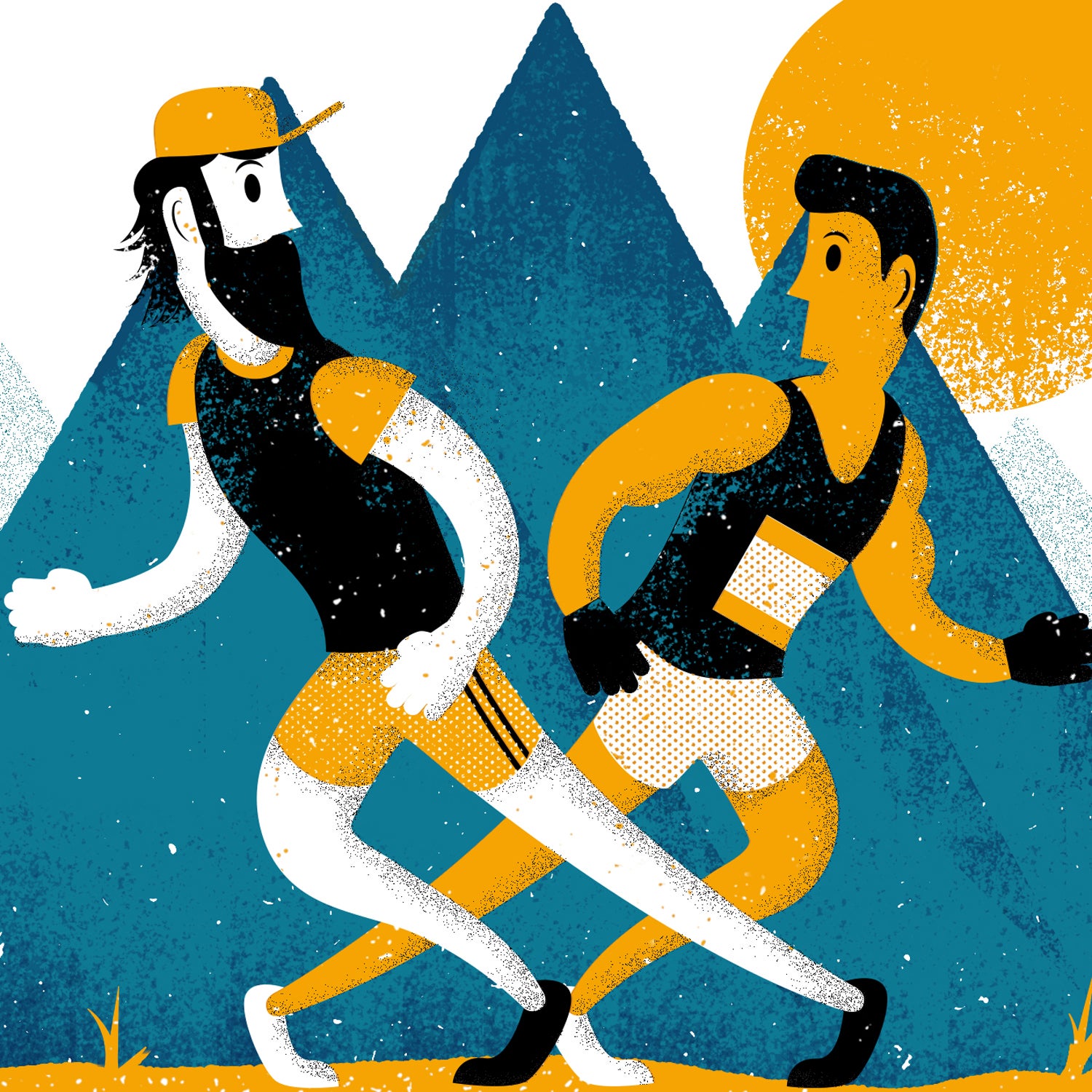Recently, I spent a day as a spectator at the world’s longest footrace, a 3,100-mile run in Queens, New York, in which twelve participants attempt to run around the same city block 5,649 times. The winner of this year’s event, a Finnish courier named Ashprihanal Aalto, did it in 40 days and nine hours, a new record. Aalto, who is 44 years old, was competing for the 13th time and is described in the athlete bios section of the race program as “one of the world’s best endurance runners.”
Reading this, I was reminded of the old sports cliché “you’re only as good as your competition.” While Ashprihanal Aalto can justifiably claim to be the planet’s premier 3,100-mile runner, to name him as one of the world’s best endurance runners seems willfully naïve. It should go without saying that being the best at something that only twelve people do every year (and in 2015 ten of the twelve 3,100 milers were returnees) isn’t comparable to being, for instance, a world-class marathoner, a distance which over half a million runners compete at annually in the U.S. alone.
What would happen if top-tier athletes from the mainstream world of track and road racing began taking a greater interest in events that have heretofore been on the periphery of the running scene? While it is unlikely that we’ll ever see Mo Farah dedicating a month of his life to running around a block in Queens, the boom in trail and ultrarunning over the past decade has already prompted a number of talented track athletes to try their hand at a sport which was once, as Outside has written before, a “fringe pursuit.”
The results have been telling.
At last month’s USATF Mountain Championships in Bend, Oregon, all of the top finishers were athletes with track and field backgrounds. The winner, Patrick Smyth, a 62-minute half marathoner and a 7-time NCAA All-American while at Notre Dame, also shattered the course record at this year’s Way Too Cool 50K.
“Some of these guys are like, ‘I’m doing my easy days at 6-minute pace and these schlubs are getting paid to run up and down mountains–I should give it a shot,’” Anton Krupicka says.
For hardened ultrarunners, a 50K may sound like child’s play, as it’s “only” tacking on another 8K to a standard marathon. Yet Max King, a standout collegiate steeplechaser at Cornell, won the IAU world championship in the 100K, a title to go along with his 2011 victory at the world mountain running championships. And last year, in his Western States debut, King finished 4th.
If Western States is a true test for aspiring ultrarunners, it bears stating that two-time defending champion Rob Krar, who is arguably the best American ultrarunner at the moment, was a standout D1 track athlete at Butler and 65-minute half marathoner.
While guys like Smyth, King, and Krar are very good road runners, with marathon PRs of 2:15, 2:14, and 2:25 respectively, they are not exceptional when measured against the best in the country; Smyth and King qualified for the Olympic marathon trials in 2012, but were nowhere near making the Olympic team. If such “second tier” talent from the world of professional track and field and road racing can win some of the big name trail and ultra races, does it follow that the heroes of the latter scene, like Anton Krupicka and Kilian Jornet, are only so successful because there’s been no incentive, financial or otherwise, for the best marathoners to take them on?
When I put the latter question to Krupicka, he ceded that trail running could be an attractive alternative for those who don’t quite make the cut at elite level road racing.
“If you can run a marathon on the road between, say, 2:13 to 2:20, that’s going to be some very significant fitness on the trails, but it gets you almost nothing on the roads,” Krupicka said. “You’ve got to be going about 2:10, 2:11 to make an impact on the national [road racing] scene. So, yeah, some of these guys are like ‘I’m doing my easy days at 6-minute pace and these schlubs are getting paid to run up and down mountains–I should give it a shot.’”
However, Krupicka was quick to point out that road race speed was not a guarantee of success in trail running. He said that despite the impressive performances of guys like Max King, there were a number of sub 2:20 marathoners—Tim Tollefson (2:18) and Ryan Bak (2:14) for instance—who’ve been unable to establish themselves in more competitive ultras.
Asked why he thought that was, Krupicka explained that longer, more extreme events ultimately require a separate skill set, both in terms of physical fitness and fortitude. While faster courses like the Way Too Cool 50K will always play into the hands of those with a “traditional” racing background, marquee events on the ultra scene like the Ultra Trail du Mont-Blanc are a different animal altogether.
“A lot of the races in North America are smooth, fast, and flat,” Krupicka said. “But in Europe, there’s generally more vertical and it’s a little more technical and you’re often starting at night. In the Alps and in the Pyrenees the weather is generally more volatile than it is, say, in California. So there are a lot of different variables and it remains to be seen whether those guys with the track/road background can make an impact on the international scene.”
Mo Farah disclosed that burgers are his favorite food and that he eats about one a year. Krupicka, on the other hand, sounded mildly grateful when he told me that ultrarunning “was not mature enough to where you need to live like a monk in order to succeed.”
That international scene (along with the more treacherous among U.S. ultras) has been dominated by Kilian Jornet in recent years. The Spaniard, who grew up in the mountains and races Skimo in the offseason, has stood atop the podium in many, if not most, of the world’s most prestigious ultras, be it Western States (’11), Mont-Blanc (’11, ’09, ’08), or the Hardrock 100 (’14, ’15).
But one thing that’s noteworthy about Jornet’s remarkable performances is the way he has been able to combine them with other pursuits, like FKT-ing the world’s highest peaks and various feats of alpinist derring-do. Prior to his debut at the Hardrock 100 in 2014, Jornet spent weeks leading up to the race skiing and climbing around Mt. McKinley. In the event itself, which he won in record time, Jornet actually waited for the next competitor at an aid station.
When you compare this well-rounded versatility in the mountains approach to the kind of hyper-regimented training and racing required of those who are among the best track and field athletes, it becomes apparent that there is still a difference in the degree of professionalism required to win at the top level in each respective sport. In a BBC interview, Mo Farah disclosed that burgers are his favorite food and that he eats about one a year. Krupicka, on the other hand, sounded mildly grateful when he told me that ultrarunning “was not mature enough to where you need to live like a monk in order to succeed.”
Of course, “maturity” can sometimes come at quite a cost, and not just for runners who can no longer place in the top ten in races that they used to win. To claim that an increase in professionalization of a sport is always a good thing is an ambiguous statement at best and the constant doping scandals in track and field are a grim reminder that upping the competitive stakes will also provide further incentive for those who will do “whatever it takes” to win.
As corporate behemoths like Nike start sponsoring their own trail teams to take on Salomon-sponsored athletes like Kilian Jornet, certain purists have already wondered if ultrarunning may one day become too competitive for its own good.
That is one problem, which, for now, no die-hard 3,100 miler will need to worry about.


